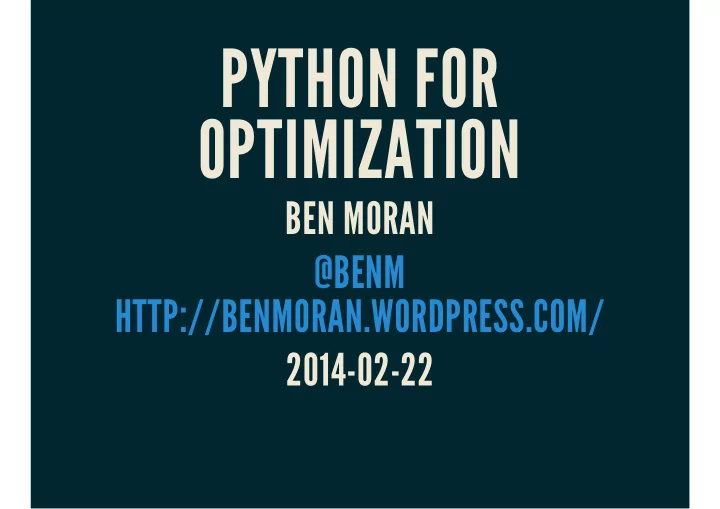

PYTHON FOR OPTIMIZATION BEN MORAN @BENM HTTP://BENMORAN.WORDPRESS.COM/ 2014-02-22
INTRODUCTION Python for optimization Not optimizing Python programs Not website optimization/SEO Mathematical optimization! scipy.optimize and friends
MATHEMATICAL OPTIMIZATION
OBJECTIVE FUNCTION
WITH CONSTRAINTS
APPLICATIONS Engineering Finance Operations Research Machine learning Statistics Physics
PYTHON FOR OPTIMIZATION Exploration/visualization: IPython notebook/Matplotlib/… As a high level modelling language Batteries included: scipy.optimize , statsmodels , 3rd party solver support Cython, etc. for C bindings and high performance code
REST OF THE TALK Numerical optimization vs symbolic manipulation General purpose solvers: scipy.optimize Linear/convex solvers: Python as a modelling language Smooth optimization: Sympy for derivatives
OPTIMIZATION TYPES
NO STRUCTURE import numpy as np xx = np.arange(1000) f = np.random.randn(len(xx)) x = np.argmin(f)
LOTS OF STRUCTURE xx = np.arange(1000) f = 2*xx x = np.argmin(f)
QUADRATIC xx = np.arange(-1000,1000) f = (xx-400)**2 x = np.argmin(f)
SCIPY.OPTIMIZE import numpy as np import scipy.optimize f = lambda x: np.exp((x-4)**2) return scipy.optimize.minimize(f, 5) status: 0 success: True njev: 8 nfev: 24 hess_inv: array([[ 0.49999396]]) fun: 1.0 x: array([ 3.99999999]) message: 'Optimization terminated successfully.' jac: array([ 0.])
CHOOSING A SOLVER METHOD Methods in scipy.optimize.minimize BFGS (default) 1st Nelder-Mead Powell CG 1st Newton-CG 2nd Anneal Global dogleg 2nd L-BFGS-B 1st bounds TNC 1st bounds Cobyla inequality SLSQP equality/inequality
SIZE: FROM LOW TO HIGH DIMENSIONAL
SMOOTHNESS: FROM SMOOTH TO DISCONTINUOUS
GLOBAL SHAPE: FROM LINEAR TO STRICTLY CONVEX TO MANY LOCAL MINIMA
NELDER-MEAD Just uses continuity, expects few minima import numpy as np import scipy.optimize f = lambda x: np.exp((x-4)**2) return scipy.optimize.minimize(f, 5, method='Nelder-Mead') status: 0 nfev: 32 success: True fun: 1.0 x: array([ 4.]) message: 'Optimization terminated successfully.' nit: 16
SIMULATED ANNEALING Expects multiple minima import numpy as np import scipy.optimize f = lambda x: np.exp((x-4)**2) return scipy.optimize.minimize(f, 5, method='anneal') status: 0 success: True accept: 0 nfev: 251 T: inf fun: 6.760670043672425 x: array(2.617566636676699) message: 'Points no longer changing' nit: 4
NEWTON'S METHOD import numpy as np import scipy.optimize f = lambda x: np.exp((x-4)**2) fprime = lambda x: 2*(x-4)*np.exp((x-4)**2) return scipy.optimize.minimize(f, 5, jac=fprime, method='Newton-CG') status: 0 success: True njev: 24 nfev: 7 fun: array([ 1.]) x: array([ 4.00000001]) message: 'Optimization terminated successfully.' nhev: 0 jac: array([ 2.46202099e-08])
USAGE TIPS check warnings consider tolerances check_grad if supplying derivatives
PYTHON FOR MODELLING For large scale problems When we need to go fast Specialized solvers
LINEAR PROGRAMS AND PULP minimize f ( x ) = Ax + b subject to Cx ≤ b http://pythonhosted.org/PuLP/ Modelling language for LP's Backends including Coin-OR, GLPK, Gurobi Supports integer constraints PuLP simple LP PuLP Sudoku
CVXPY Nonlinear convex optimization, backed by CVXOPT The LASSO -penalized least squares problem: L 1 from cvxpy import * import numpy as np import cvxopt # Problem data. n = 10 m = 5 A = cvxopt.normal(n,m) b = cvxopt.normal(n) gamma = Parameter(sign="positive") # Construct the problem. x = Variable(m) objective = Minimize(sum(square(A*x - b)) + gamma*norm1(x)) p = Problem(objective) gamma.value = 0.2 result = p.solve() return p.is_dcp()
WIDE RANGE OF EXPRESSIONS kl_div(x, y) KL divergence lambda_max(x) , lambda_min(x) the max/min eigenvalue of . x log_det for a positive semidefinite matrix . log(det( x )) x norm(x, [p = 2]) , L1/L2/infinity/Frobenius/Spectral norm of x
DERIVATIVES AND SYMPY
LEAST SQUARES VIA THE FEYNMAN ALGORITHM Write down the problem… a i ) 2 minimize f ( x ) = ∑ ( x i − i … think really hard …
… AND THEN WRITE DOWN THE ANSWER! a i ) 2 minimize f ( x ) = ∑ ( x i − i Take derivatives The gradient is flat at the bottom of the hill. We can find the gradient in each direction explicitly, and set it to zero: x i ∂ f = 2( x i − a i ) = 0 ∂ x i
WHERE TO GET DERIVATIVES FROM? Numerical approximation - numdifftools ( Automatic differentiation - Julia, Stan, ADMB… ) Pencil and paper! Sympy
CONCLUSION To choose a solver: Small problem/no hurry Use whatever you like! Big problem/top speed Understand and specialize Really big problem Try online methods like SGD Don't understand the problem at all? Try a genetic algorithm
Recommend
More recommend